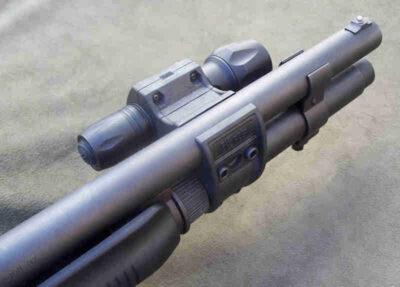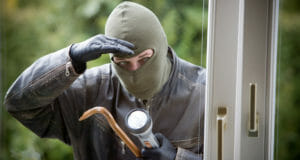A shotgun is the ideal choice for a home defense firearm for many gun owners. There are great reasons for this: avoidance of over-penetration, slightly less demanding accuracy standards in less-than-perfect shooting conditions, and mighty stopping power. Practically every conversation about home defense shotguns also includes mention of that ominous racking sound—but I hope no one is depending on sound effects to scare off intruders, when real force may be necessary.
Like anything else associated with the word “tactical” these days, a plethora of add-ons are available for defense shotguns, not all of which are really useful. Here, I’ll point out a few that are worth the investment for mounting an effective—and ethical—counterattack with a shotgun.
1. A sling
The larger your property, the more complicated your responsibilities at home, the more a sling makes sense. Being able to navigate space hands-free is a major asset; however, it’s also a good idea to keep your gun with you. A sling lets you do both.
Options for slings and sling mounts are many. From a simple latigo strap threaded through the swivel loops on a hunting rifle (making a two-point configuration that’s easy to shoulder), to a one- or three-point tactical setup that allows more options for the method of carry, this is a highly customizable choice.
Be Prepared. Learn The Best Ways To Hide Your Guns.
Expect to spend $20 to $35 for an entry-level tactical sling. Mounts are generally higher in price, starting at $25 and priced up to $75. Before purchasing a sling/mount set, make sure your shotgun has studs, rails or whatever is needed to attach the mounts. It would seem to go without saying, but make sure the sling’s hardware is a match for what’s on the gun. Paracord is a frequently used accessory for making stiff connections easier to work with, and for making a too-wide sling work with narrow loops or rings.
2. On-board ammunition
Let’s assume your gun’s capacity is more typical, between two and six rounds. Even six rounds may not be enough in dire situations where multiple attackers or poor marksmanship have created the need for more ammo.
Where will more ammo go? As with slings, there are choices. I’ll eliminate things like belt-mounted ammo storage for this discussion, since this is about ammo that’s needed in fast order—so it needs to be in or on the gun.
Extended magazine tubes are one choice, and the shortest distance between need and a hot chamber. Alternative mag tube choices exist for common platforms like the Remington 870, Mossberg 500, and their variants. A couple brands also have manufactured their parts to be compatible with Remington or Mossberg mag tubes, but be sure to check the specs before purchase. Expect to spend $50 to $80 on an extension for a magazine tube.
Not crazy about the idea of modifying your scattergun? One alternative is a cloth cartridge holder, which can stretch over or Velcro onto the buttstock, keeping ammo at the ready. I did find it necessary to secure this sock-like accessory with tape when I used one to prevent it from sliding around. That might be undesirable if you aim to preserve a finished wood stock.
Similar to a cloth cartridge holder, but possibly requiring some modification, is a sidesaddle-type shell carrier. These can be mounted anywhere from the buttstock to the receiver, depending on design, and price can vary from $25 to more than $100, depending on material and capacity.
Left-handed shooters should note that many cartridge storage products are made with a right-hand bias, and may not be usable without modifications.
One advantage of an external ammo storage system is being able to organize, and see, ammunition types in relation to their position on the gun. Methods vary, but some defenders like to have one type of ammo, like buckshot, in the magazine, and birdshot ready in the most available loading position. Perhaps slugs will be in the rearmost position. Storing the shells with primer up or down, or a combination thereof, also can help indicate ammo type in a high-pressure situation.
3. Auxiliary light
It’s your legal and ethical obligation to correctly identify a threat before firing. The handful of tragedies and more near-tragedies that happen annually due to failure to identify the target are inexcusable.
We’re talking about a gun that you’re likely to use in the dark hours. Light is a must for identifying your target. It also might serve as a navigational or signaling aid, but this kind of use should be minimized since, with a weapon-mounted light, the muzzle will cover everything you light up—a shaky proposition from both safety and legal viewpoints; the latter especially applies when outside of your residence.
Wouldn’t a nice flashlight do just as well? Perhaps, but most people aren’t prepared to wield both a flashlight and a long gun while making accurate shots. So a gun-mounted light makes sense, though it cannot avoid the muzzling issue, so that safety rule about keeping your finger off the trigger until the sights are on target and you’ve decided to shoot applies — in spades.
Entry level long gun-mounted lights begin at around $65. Prices climb rather dramatically after that, with some excellent choices available for less than $200. You’ll want to select a light with a pressure switch — that is, one that you can operate with the hand that’s on the forend, and one that turns off as soon as you release pressure. When someone’s trying to kill you, it’s a good idea not to reveal your position with light more than necessary.
4. Tritium front sight
Least beneficial but still useful of the four items here is a front sight with a tritium insert, which glows in the dark and is visible only behind the gun. Without it, only a silhouette of the front sight will be visible with a weapon-mounted light. This accessory will cost $60-$100, but consider hardware and gunsmith costs. as well. Be sure to practice with any sight system so you know where your shots will impact at typical close-range distances, and adjust your sights accordingly, or adjust your hold if the sights are non-adjustable.
Hopefully. this has given you some ideas of choices to accessorize your home shotgun to make it safer and more effective for defensive use. While these gadgets are useful, having them is only half the equation. Practice, and with that, knowing how to use them in dim light, is equally valuable.
If readers have experience with other shotgun accessories they’re fond of, I’m interested in hearing about them.
Do you have other favorite shotgun accessories? Share your tips in the section below:
Pump Shotguns Have One BIG Advantage Over Other Shotguns For Home Defense. Read More Here.
 Off The Grid News Better Ideas For Off The Grid Living
Off The Grid News Better Ideas For Off The Grid Living





